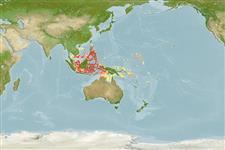>
Ovalentaria/misc (Various families in series Ovalentaria) >
Plesiopidae (Roundheads) > Acanthoclininae
Etymology: Acanthoplesiops: Greek, akantha = thorn + Greek, plesios = near + Greek, ops = similar (Ref. 45335).
Environment: milieu / climate zone / depth range / distribution range
पारिस्थितिकी
समुद्री; गहराई सीमा 8 - 34 m (Ref. 90102). Tropical
Western Pacific: the Philippines and Indonesia.
आकार / वज़न / Age
Maturity: Lm ? range ? - ? cm
Max length : 4.0 cm TL पुल्लिंग / अलिंग; (Ref. 48635)
पृष्ठीय रीढ़ (सम्पूर्ण): 19 - 20; पृष्ठीय सौफट रेज़ (सम्पूर्ण): 5-6; गुदा कांटा 8; ऐनल सौफट रेज़: 6. Pale cream and distinctively marked with black banding over the top, anal fin and a vertical band on the caudal fin base (Ref. 48635).
Secretive in sheltered reefs to about 20 m depth (Ref. 48635); a few species collected from reef crevices in 8-34 m (Ref 90102). Eggs are guarded by the male parent (Ref. 205).
Life cycle and mating behavior
परिपक्व अवधि | पुनरुत्पत्ति | मछलीऔ का अंडे देना | अंडे | Fecundity | लार्वा
Eggs are guarded by the male parent (Ref. 205).
Mooi, R.D., 1999. Plesiopidae. Roundheads (prettyfins, longfins). p. 2578-2585. In K.E. Carpenter and V.H. Niem (eds.) FAO species identification guide for fishery purposes. The living marine resources of the WCP. Vol. 4. Bony fishes part 2 (Mugilidae to Carangidae). FAO, Rome. (Ref. 12926)
IUCN Red List Status (Ref. 130435)
Threat to humans
Harmless
Human uses
अधिक जानकारी
आम नामउपशब्दचपायचयपरभक्षीईकोटोकसीकोलौजीपुनरुत्पत्तिपरिपक्व अवधिमछलीऔ का अंडे देनाSpawning aggregationFecundityअंडेEgg development
संदर्भजलीयकृषिजलीयकृषि रूपरेखाखींचआनुवंशिकीElectrophoresesहैरेटिबिलटीबीमारीप्रक्रमणNutrientsMass conversion
सहयोगीयोतस्वीरेStamps, Coins Misc.ध्वनिसिगुयटिरारफ्तारतैरने के प्रकारगिल क्षेत्रOtolithsदिमागदृष्टि
साधन
Special reports
Download XML
इंटरनेट स्रोत
Estimates based on models
Preferred temperature (Ref.
123201): 28 - 29.1, mean 28.5 °C (based on 44 cells).
Phylogenetic diversity index (Ref.
82804): PD
50 = 0.5156 [Uniqueness, from 0.5 = low to 2.0 = high].
Bayesian length-weight: a=0.00457 (0.00180 - 0.01158), b=3.10 (2.87 - 3.33), in cm total length, based on LWR estimates for this (Sub)family-body shape (Ref.
93245).
Trophic level (Ref.
69278): 3.6 ±0.59 se; based on food items.
लौटाव (Ref.
120179): ऊंचा, न्यूनतम जनसंख्या दुगनी समय अवलागत 15 महीने। (Preliminary K or Fecundity.).
Fishing Vulnerability (Ref.
59153): Low vulnerability (10 of 100).
